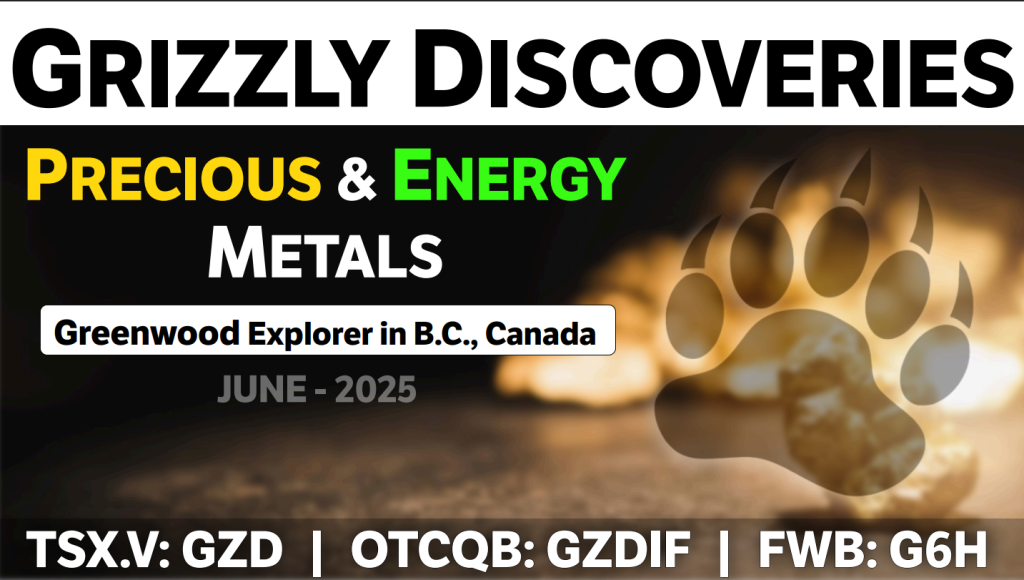
Website: https://www.grizzlydiscoveries.com/
Contact: 780.712.3559
📈🪙 Invest in your future with precious metals! Check out these incredible deals from Miles Franklin:
Order Now! Call Maurice Jackson at 855.505.1900!

#PreciousMetals #Gold #Silver #Platinum #InvestInGold #Investment #MilesFranklin #FinancialFreedom @MilesFranklinPM @MauriceJackson
Gold has firmly reasserted itself as a strategic anchor in the global financial system, now ranking second only to the US dollar—and ahead of the euro—in terms of official reserve holdings measured at market value. This structural shift, outlined in the European Central Bank’s latest report on the international role of the euro, underscores how price dynamics, central bank behavior, and geopolitical realignment have collectively elevated gold’s monetary relevance.
In 2024, gold prices surged by 30%, followed by another 30% year-to-date in 2025, briefly reaching an all-time nominal high of $3,500 per troy ounce in April. This sharp rally signals more than just a technical or inflation-driven cycle—it reflects a broader revaluation of gold’s role amid rising global uncertainty.

One of the more recent illustrations of this shift came with the spike in gold futures following a military flare-up between Israel and Iran, confirming gold’s renewed function as a geopolitical hedge.
While traditionally influenced by real interest rates and inflation expectations, gold has increasingly decoupled from such monetary drivers. Between 2008 and early 2022, the negative correlation between gold prices and real yields made the metal a reliable hedge in low-rate or high-inflation environments. Yet since Russia’s invasion of Ukraine, this pattern has weakened significantly. Despite rising or stable real yields, gold has continued to climb, suggesting that its valuation is being driven by forces beyond rate expectations.
Non-monetary factors have now taken center stage—especially geopolitical risk, reserve diversification, and sanctions avoidance. This transformation reflects a recalibration by central banks and investors alike, who are positioning gold not only as an inflation buffer, but also as a politically neutral store of value. In an era of increasing geopolitical fragmentation and weaponized finance, gold’s lack of counterparty risk has made it uniquely attractive.
The implications are far-reaching. If gold is no longer primarily priced off opportunity cost or real yields, then conventional valuation models understate its defensive strength. Instead, gold is behaving more like a global insurance asset, valued for its sovereignty-proof liquidity and its historical reliability in times of crisis.
The most significant force behind gold’s recent ascent is central banks’ purchases. In 2024, central banks bought over 1,000 tonnes of gold—double the prior decade’s average—pushing global official holdings to 36,000 tonnes, near the 1965 Bretton Woods peak of 38,000 tonnes. This unprecedented accumulation lifted global official holdings to 36,000 tonnes, approaching the historic peak of 38,000 tonnes reached in 1965 during the Bretton Woods era.
At current market valuations, these holdings have pushed gold’s share in total global foreign exchange reserves to 20%, overtaking the euro’s 16% for the first time according to the ECB’s recent findings. This milestone is not the result of speculative demand, but of deliberate, sustained reallocation by central banks—signaling a strategic repricing of gold as a monetary reserve asset.
Notably, this wave of buying has been highly concentrated in emerging markets, particularly China, Turkey, and India, which together have added more than 600 tonnes since late 2021. Their purchases reflect a broader movement among non-Western economies to de-risk from reserve currencies tied to Western financial systems and legal jurisdictions.
Survey data from the World Gold Council conducted in early 2024 helps unpack the motives behind this buying. Diversification remains the primary rationale, cited by two-thirds of central banks. However, geopolitical risk—specifically the desire to insulate reserves from sanctions or political pressure—was cited by 40% of respondents. A substantial number of central banks also pointed to gold’s role as a long-term hedge against inflation, default risk, and systemic disruption.
These motivations are particularly strong in emerging and developing economies, where one in four central banks explicitly linked their gold strategy to concerns over sanctions or anticipated changes in the global monetary order. In fact, half of the top ten annual jumps in gold’s reserve share since 1999 followed sanctions against the countries involved. This underscores gold’s appeal as an unencumbered asset, free from the risks of seizure or political interference.
Taken together, these trends mark a departure from reserve management as a purely financial optimization exercise. Today, for many sovereign actors, gold serves as a hedge not just against inflation or currency depreciation, but against the rules of the existing system itself.
The ECB’s findings reflect a broader paradigm shift in the logic of reserve accumulation. Gold has not only appreciated in nominal terms—it has been reconceptualized as a core asset for monetary sovereignty and geopolitical insulation.
Its elevation to second place in global reserves is more than symbolic. It signals a growing distrust in traditional reserve currencies and a collective desire among central banks—particularly outside the Western alliance—to build resilience against political and financial coercion.
In this new global context, gold is no longer a passive relic of the past. It is increasingly being recognized as an active pillar of reserve strategy, with implications that stretch far beyond price charts and interest rate models.
This article was originally posted on FX Empire
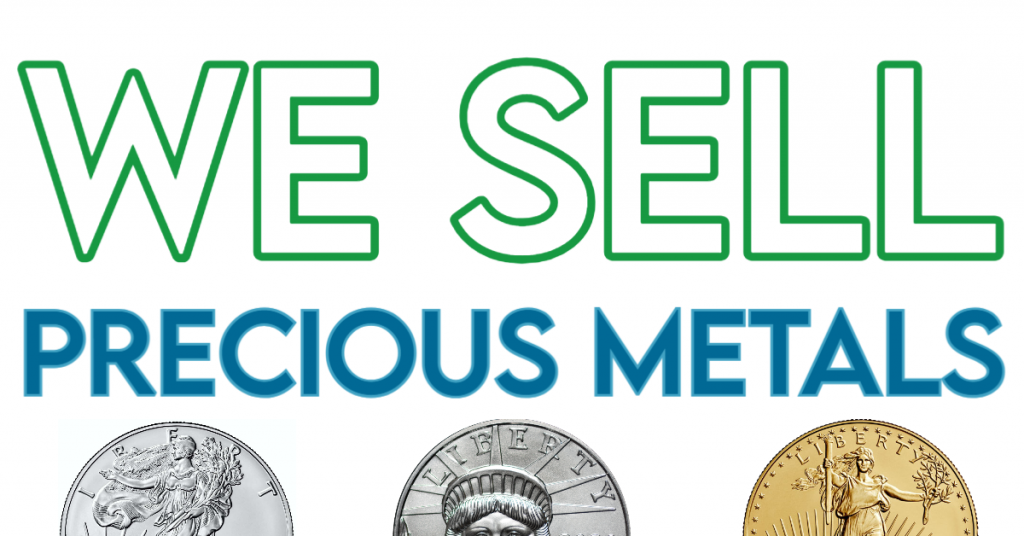









Kelowna, British Columbia–(Newsfile Corp. – June 3, 2025) – Strathmore Plus Uranium Corporation (CSE: SUU) (OTCQB: SUUFF) (“Strathmore Plus” or “the Company“) is pleased to announce the initiation of a non-brokered private placement (the “Offering”) to raise gross proceeds up to $1,000,000 from the sale of 8,333,334 units of the Company (each, a “Unit”) at a price of C$0.12 per Unit (the “Offering Price”).
Each Unit consists of one common share of the Company (each, (a “Common Share”) and one Common Share purchase warrant (each, a “Warrant”). Each Warrant will be exercisable to acquire one additional common share at an exercise price of $0.15 per share for a period of 36 months following the issue date of the Units.
The net proceeds of the Offering will be used for working capital and further exploration of the Company’s Wyoming properties. Finder’s fees and/or commissions may be paid in connection with that funding. This news release is for information purposes only and does not constitute an offer to sell or a solicitation of an offer to buy any securities of the Company in any jurisdiction.
All securities issued pursuant to the Offering will be subject to a hold period of four (4) months and a day from the closing date in accordance with securities laws. Insiders are expected to participate in the Offering. Any participation by insiders in the Offering will constitute a related party transaction under Multilateral Instrument 61-101 – Protection of Minority Security Holders in Special Transactions (“MI 61-101“) but is expected to be exempt from the formal valuation and minority shareholder approval requirements of MI 61-101. The closing of this Offering remains subject to several conditions including receipt of subscriptions and regulatory approval, if required.
About Strathmore Plus Uranium Corp.
Strathmore is focused on discovering uranium deposits in Wyoming, and has three permitted uranium projects including Agate, Beaver Rim, and Night Owl. The Agate and Beaver Rim properties contain uranium in typical Wyoming-type roll front deposits based on historical drilling data. The Night Owl property is a former producing surface mine that was in production in the early 1960s.
Strathmore Plus Uranium Corp.
Contact Information:
Jamie Bannerman
Telephone: 1 250-868-6553
Email: jamie@rdcapital.com
ON BEHALF OF THE BOARD
“Dev Randhawa”
Dev Randhawa, CEO
Cautionary Statement: “Neither the CSE Exchange nor its Regulation Services Provider (as the term is defined in policies of the CSE Exchange) accepts responsibility for the adequacy or accuracy of this release”.
Notice Regarding Forward-Looking Statements
This news release may contain certain “forward looking statements.” Forward-looking statements involve known and unknown risks, uncertainties, assumptions, and other factors that may cause the actual results, performance, or achievements of the Company to be materially different from any future results, performance or achievements expressed or implied by the forward-looking statements. Any forward-looking statement speaks only as of the date of this news release and, except as may be required by applicable securities laws, the Company disclaims any intent or obligation to update any forward-looking statement, whether as a result of new information, future events, or results or otherwise.
SOURCE: Strathmore Plus Uranium Corp.
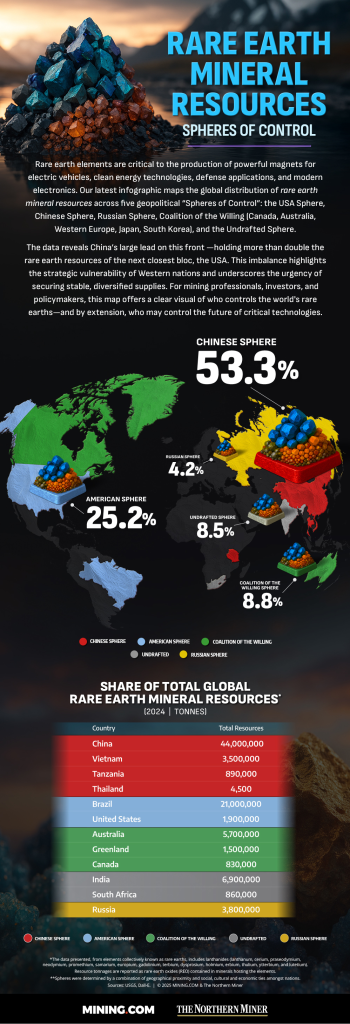
MINING.COM and The Northern Miner mapped global rare earth production through a geopolitical lens, dividing the world into five “spheres of control”: Chinese, American, Russian, Coalition of the Willing, and Undrafted.
These groupings reflect geographic, social, cultural, and economic ties—and possible alignments in a more polarized world.
Watch: In this 18-minute presentation at the CentralMinEX conference in Newfoundland, TNM Group President Anthony Vaccaro examines how the world is fracturing into competing spheres of control.
(By Anthony Vaccaro; Files from: Ali Ravaghi; Creative: James Alafriz)

Silver is getting its shine on, with the price reaching $34 an ounce on Monday – an overall 19% increase so far this year, and rivalling in on the performance of its sister metal, gold, up 29%.
Unlike gold, silver benefits not only from a surge in investments into safer assets during times of uncertainty, but also upturns in economic outlook, given the metal’s use in industrial applications.
The Silver Institute projects demand for silver will remain healthy in the coming years, owing to an anticipated rise in consumption for industrial uses such as photovoltaics, electronics and electric vehicles. In 2025, global demand is expected to reach 1.2 billion oz., over half of which from industrial fabrication (700 million oz.).
The Silver Institute is forecasting mine production to reach a seven-year high in 2025, rising by 2% to 844 million ounces, guided by anticipated output growth from both existing and new operations around the world.
We rank the top 20 silver-producing operations of 2024, based on their actual or estimated output in millions of ounces (Moz):
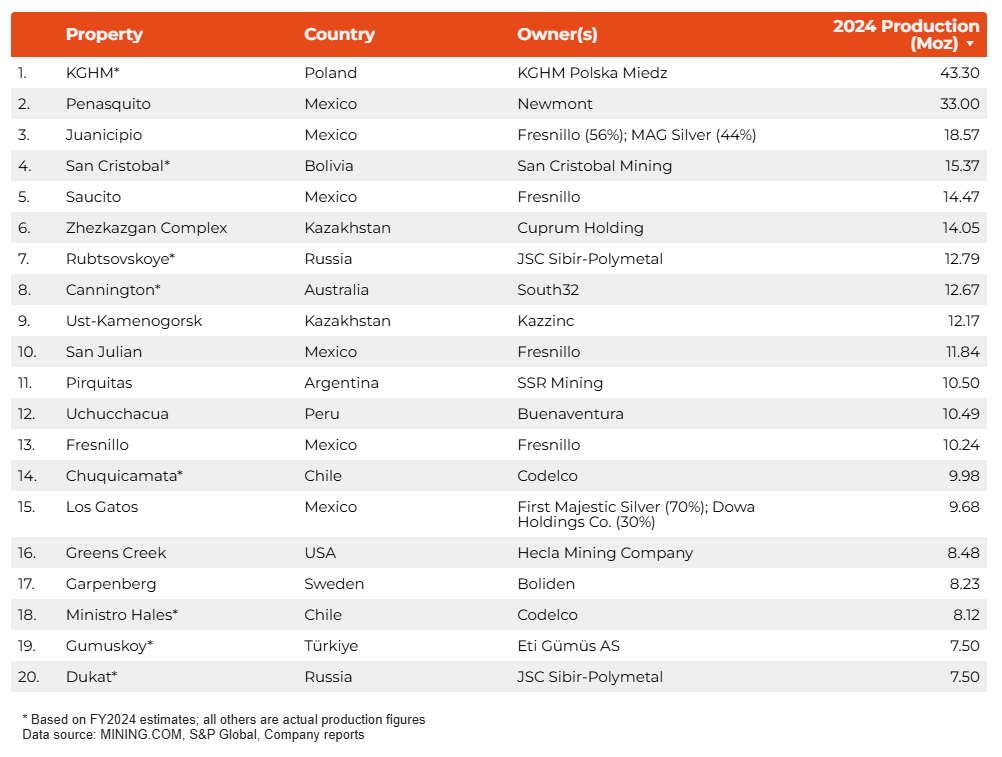
Topping our list are KGHM’s collective operations in Poland, with an estimated 43.3 Moz ounces produced from its Carlota, Lubin, Polkowice-Sieroszowice, Robinson, Rudna and Sierra Gorda mines. KGHM’s silver production is a by-product of its copper operations, which also made our top copper mines ranking.
Newmont’s Penasquito mine in Mexico is number two, with 33 Moz produced in 2024. The company struck a collective bargaining agreement with workers that year, after a series of strike actions in 2023 that saw employees at Peñasquito, Mexico’s largest gold mine, down tools for over four months.
The Juanicipio mine in Mexico, a joint venture between Fresnillo (56%) and Canada’s Mag Silver (44%) is in third place with 18.57 Moz produced in 2024. Fresnillo began developing the project in 2019, but only began operating the mine in late 2022, as pandemic and logistical setbacks delayed the project.
San Cristóbal Mining’s San Cristóbal mine in Bolivia is in fourth place with an estimated 15.36 Moz produced in 2024. Located in Bolivia’s Potosí Department, San Cristóbal is also globally significant zinc and lead producer.
Fresnillo’s Saucito mine in Mexico is number five with 14.47 Moz ounces produced in 2024. Saucito contributed 25.7% to Fresnillo’s total silver production for the year and generated 20.9% of total adjusted revenue.
Cuprum Holding’s Zhezkazgan Complex is the largest silver producing mine in Kazakhstan, churning out 14.05 Moz in 2024.
The Rubtsovskoye mine in Russia, owned by JSC Sibir-Polymetal produced an estimated 12.78 Moz in 2024. Polymetal’s Russian assets were placed under US sanctions in 2023 and the company switched its domicile to Kazakhstan and listed on the Central Asian nation’s Astana International Exchange to try to facilitate a sale. In 2024, it sold its Russian assets to a Siberian gold miner for about $3.7 billion.
South 32’s Cannington in Australia is in eighth place with 12.66 Moz produced. The mine is located in North West Queensland, on an old sheep and cattle station.
Kazzinc Consolidated’s Kazzinc mine in Kazakhstan is number nine, with 12.171 Moz produced. Kazzinc complex is located in the western region of the Shatskaya metaliogenic zone in north Kazakhstan.
Fresnillo’s San Julian mine in Mexico churned out 11.83 Moz in 2024. According to the company, the geological potential identified in the San Julian mine’s region may be sufficient to establish a new mining district in the future.
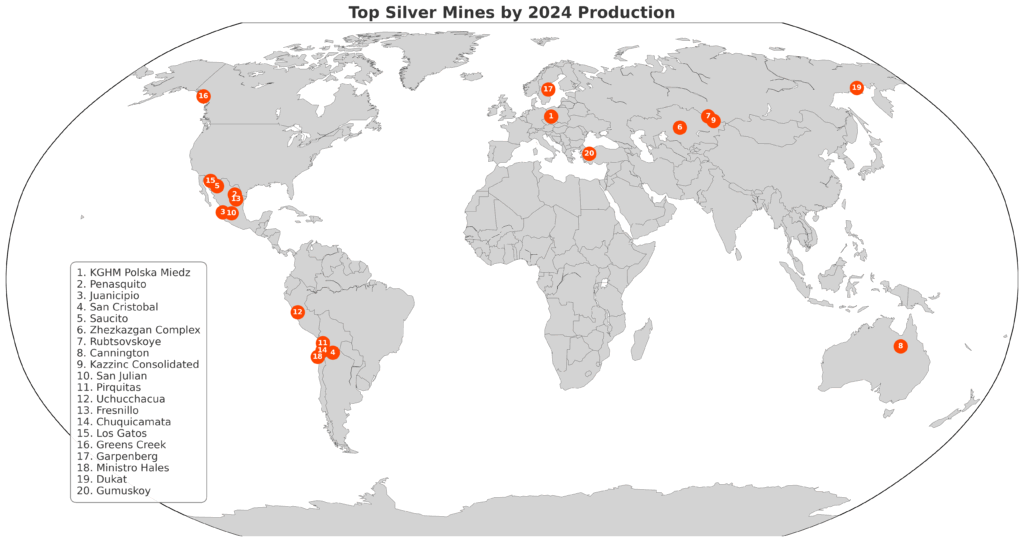
Pirquitas mine, located in Jujuy Province of Argentina and owned by SSR Mining, ranks 11th with 10.5 Moz produced. Pirquitas combined with the nearby Chinchillas mine in 2015, to comprise the Puna Operations, which includes processing facilities.
Buenaventura’s Uchucchacua mine in Peru’s Oyón province produced 10.49 Moz of silver in 2024. The mine started operations in 1975, and over the years the company has faced land use disputes with the Oyon people of the Andes.
Fresnillo’s eponymous mine in Mexico produced 10.24 Moz in 2024. Fresnillo, the world’s top silver producer, operates seven mines in the country.
Chile’s famed Chuquiquamata, the world’s biggest open-pit copper mine, owned by state-run miner Codelco, also produced an estimated 9.98 Moz of silver in 2024.
The Los Gatos mine in Chihuahua, Mexico, a joint venture between First Majestic Silver (70%) and Dowa Holdings (30%) churned out 9.68 ounces for the year. First Majestic acquired the stake in 2024, when it bought Los Gatos Silver in a $970 million deal.
Hecla Mining’s Greens Creek in southeast Alaska produced 8.48 Moz of silver in 2024. Greens Creek was the first US underground mine to deploy automated loading technology from Sandvik.
The Garpenberg mine in Sweden, wholly owned by Boliden, produced 8.23 Moz. Garpenberg is also the world’s most productive underground zinc mine.
Ministro Hales, run by Chile’s state owned miner Codelco, produced an estimated 8.12 Moz for the year. In 2023, Codelco said it planned to extend the useful life of Ministro Hales with a $2.5 billion investment.
The Gumuskoy mine in Turkiye’s Kütahya Province, owned by Eti Gumus AS, produced an estimated 7.5 Moz in 2024. In 2021, Gumuskoy was the world’s top producing silver mine, according to Global Data.
Rounding out the ranking is the Dukat mine in Russia, owned by JSC-Sibir Polymetal. Dukat’s estimated production for the year was on par with Gumuskoy – with 7.5 Moz.
SOURCE: https://www.mining.com/featured-article/ranked-worlds-20-biggest-silver-producing-mines/
Vancouver, British Columbia–(Newsfile Corp. – June 2, 2025) – EMX Royalty Corporation (NYSE American: EMX) (TSXV: EMX) (the “Company” or “EMX”) is pleased to announce the sale of its Nordic operational platform to First Nordic Metals Corporation (TSXV: FNM) (“FNM”), a current partner of EMX and operator on multiple EMX royalty properties in Sweden and Finland. This strategic divestment will include EMX’s infrastructure, exploration equipment and employees in the Nordic countries. EMX views this transaction as highly synergistic, as it will reduce EMX’s operational and administrative expenses while providing additional operational capacity for FNM to advance its Gold Line interests in Sweden and its Oijärvi gold project in Finland, where EMX holds royalty interests. EMX will also be granted future royalty interests on projects organically generated by FNM for a period of five years.
Strategic Rationale and Long-Term Benefits
This transaction is part of a broader initiative to streamline EMX’s global operations and reduce administrative costs while maintaining upside royalty exposure in partner-funded generative exploration efforts. EMX has been conducting generative exploration in the Nordic Countries for over 15 years and has generated a broad portfolio of royalties in the region, which will be retained by EMX. In addition, EMX will be granted future royalty interests on projects organically generated by FNM for a period of five years. This transaction fits EMX strategic objectives and provides an operational boost to an existing partner and operator.
Commercial Terms
As consideration for the sale, EMX will receive staged payments totaling 3.25 million SEK (approximately US$335,000) over a period of two years. The payments will be made in equal proportions of cash and the equivalent value in shares of FNM.
Additionally, FNM will grant EMX a 1% net smelter return (NSR) royalty on any newly generated projects in Sweden and Finland during the next five years.
Dr. Eric P. Jensen, CPG, a Qualified Person as defined by National Instrument 43-101 and employee of the Company, has reviewed, verified and approved the disclosure of the technical information contained in this news release.
About EMX. EMX is a precious and base metals royalty company. EMX’s investors are provided with discovery, development, and commodity price optionality, while limiting exposure to risks inherent to operating companies. The Company’s common shares are listed on the NYSE American Exchange and TSX Venture Exchange under the symbol “EMX”. Please see www.EMXroyalty.com for more information.
About FNM. First Nordic Metals Corp. is a Canadian-based gold exploration company, with precious metals assets in Sweden and Finland. The Company’s flagship asset is the Barsele gold project in northern Sweden, a joint venture project with Agnico Eagle Mines Limited. Immediately surrounding the Barsele project, First Nordic is 100%-owner of a district-scale license position comprised of two additional target areas (Paubäcken, Storjuktan, also EMX royalty properties), which combined with the Barsele project, total ~100 km of strike coverage of the Gold Line greenstone belt. Additionally, in northern Finland, First Nordic is the 100%-owner of the underexplored Oijärvi greenstone belt, including the Kylmäkangas deposit, the largest known gold occurrence on this belt. EMX also controls various royalty interests over FNM projects in the Oijärvi belt.
For further information contact:
| David M. Cole President and CEO Phone: (303) 973-8585 Dave@EMXroyalty.com | Stefan Wenger Chief Financial Officer Phone: (303) 973-8585 SWenger@EMXroyalty.com | Isabel Belger Investor Relations Phone: +49 178 4909039 IBelger@EMXroyalty.com |
Neither the TSX Venture Exchange nor its Regulation Services Provider (as that term is defined in policies of the TSX Venture Exchange) accepts responsibility for the adequacy or accuracy of this release
Forward-Looking Statements
This news release may contain “forward looking statements” that reflect the Company’s current expectations and projections about its future results. These forward-looking statements may include statements regarding perceived merit of properties, exploration results and budgets, mineral reserves and resource estimates, work programs, capital expenditures, timelines, strategic plans, market prices for precious and base metal, or other statements that are not statements of fact. When used in this news release, words such as “estimate,” “intend,” “expect,” “anticipate,” “will”, “believe”, “potential” and similar expressions are intended to identify forward-looking statements, which, by their very nature, are not guarantees of the Company’s future operational or financial performance, and are subject to risks and uncertainties and other factors that could cause the Company’s actual results, performance, prospects or opportunities to differ materially from those expressed in, or implied by, these forward-looking statements. These risks, uncertainties and factors may include, but are not limited to unavailability of financing, failure to identify commercially viable mineral reserves, fluctuations in the market valuation for commodities, difficulties in obtaining required approvals for the development of a mineral project, increased regulatory compliance costs, expectations of project funding by joint venture partners and other factors.
Readers are cautioned not to place undue reliance on these forward-looking statements, which speak only as of the date of this news release or as of the date otherwise specifically indicated herein. Due to risks and uncertainties, including the risks and uncertainties identified in this news release, and other risk factors and forward-looking statements listed in the Company’s MD&A for the quarter ended March 31, 2025 (the “MD&A”), and the most recently filed Annual Information Form (“AIF”) for the year ended December 31, 2024, actual events may differ materially from current expectations. More information about the Company, including the MD&A, the AIF and financial statements of the Company, is available on SEDAR at www.sedarplus.ca and on the SEC’s EDGAR website at www.sec.gov.

To view the source version of this press release, please visit https://www.newsfilecorp.com/release/254041
Vancouver, British Columbia–(Newsfile Corp. – June 2, 2025) – EMX Royalty Corporation (NYSE American: EMX) (TSXV: EMX) (the “Company” or “EMX“) is pleased to report that all proposed resolutions were approved at the Company’s Annual General Meeting of shareholders held on June 2, 2025, in Vancouver, British Columbia (the “Meeting”). The number of directors was set at 6 and all director nominees, as listed in the Management Information Circular dated April 15, 2025 (the “Information Circular”), were elected as directors of the Company at the Meeting to serve for a one-year term and hold office until the next annual meeting of shareholders. According to the proxy votes received from shareholders, the results were as follows:
| Director | Votes FOR | Votes WITHHELD |
| Dawson C. Brisco | 99.41% | 0.59% |
| David M. Cole | 99.55% | 0.45% |
| Sunny S.C. Lowe | 96.88% | 3.12% |
| Henrik K.B. Lundin | 99.34% | 0.66% |
| Geoff G. Smith | 99.52% | 0.48% |
| Michael D. Winn | 99.51% | 0.49% |
Shareholders voted 99.14% in favour of setting the number of directors at six, 99.10% in favour of appointing Davidson & Company LLP, Chartered Accountants as auditors, and 96.76% in favour of ratifying and approving the Company’s Stock Option Plan.
Voting results for all resolutions noted above are reported in the Report on Voting Results as filed under the Company’s SEDAR+ profile on June 2, 2025.
About EMX. EMX is a precious and base metals royalty company. EMX’s investors are provided with discovery, development, and commodity price optionality, while limiting exposure to risks inherent to operating companies. The Company’s common shares are listed on the NYSE American Exchange and TSX Venture Exchange under the symbol “EMX”. Please see www.EMXroyalty.com for more information.
For further information contact:
| David M. Cole President and CEO Phone: (303) 973-8585 Dave@EMXroyalty.com | Stefan Wenger Chief Financial Officer Phone: (303) 973-8585 SWenger@EMXroyalty.com | Isabel Belger Investor Relations Phone: +49 178 4909039 IBelger@EMXroyalty.com |
Neither the TSX Venture Exchange nor its Regulation Services Provider (as that term is defined in policies of the TSX Venture Exchange) accepts responsibility for the adequacy or accuracy of this release
